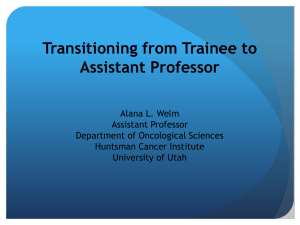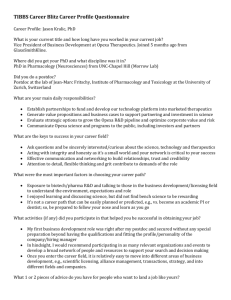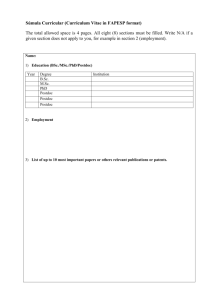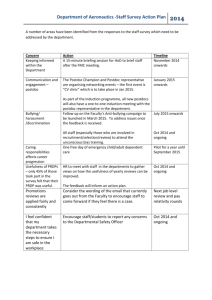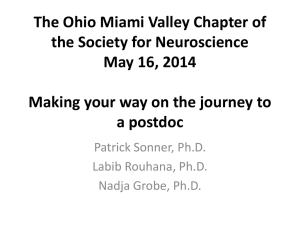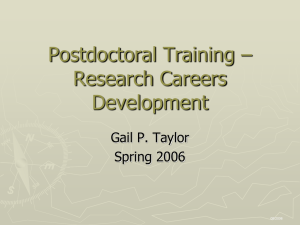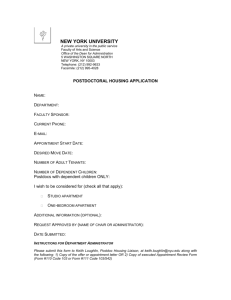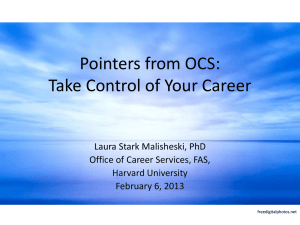The Sigma Xi Postdoc Survey Project
advertisement
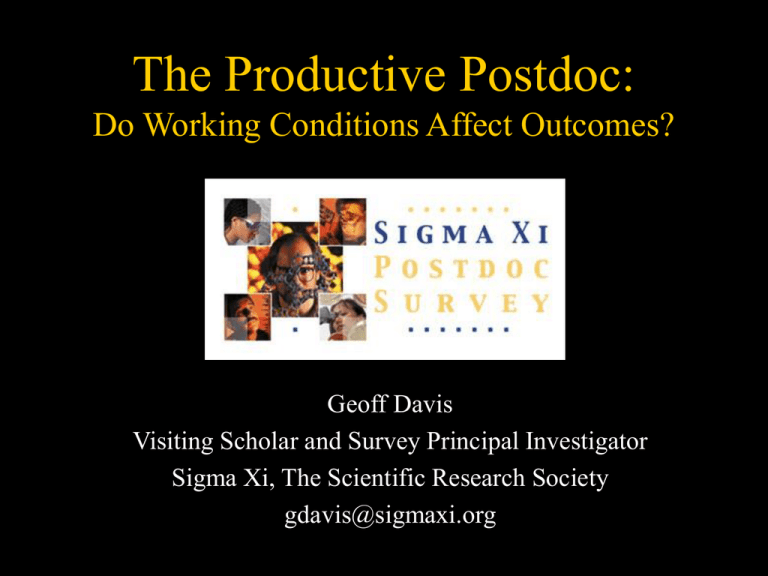
The Productive Postdoc: Do Working Conditions Affect Outcomes? Geoff Davis Visiting Scholar and Survey Principal Investigator Sigma Xi, The Scientific Research Society gdavis@sigmaxi.org Improving the Postdoctoral Experience • Many calls for changes to the postdoc – National Academies, AAU, NPA, etc • Big question: What, if anything, works? What Works? Changes have costs (money, time) Do benefits justify investments? What should priorities be? What gives the biggest bang for the buck? These are empirical questions Our “Experiment” Postdoc administration takes place largely at the level of the PI Tremendous variability in conditions from lab to lab Recent, limited introduction of new practices Natural experiment Ask postdocs about their working conditions Ask about how well they are doing Find conditions associated with positive outcomes Sigma Xi Postdoc Survey Ran a big web survey Contacted 22,400 postdocs at 47 institutions ~40% of all postdocs in US Overall response rate: 38%* (*See tech report for details) Our Sponsor The Alfred P. Sloan Foundation Alfred P. Sloan Michael Teitelbaum Additional Support Werthheim Fellowship, Harvard University Partner Organizations National Postdoc Association Science’s Next Wave NBER/Sloan Scientific Workforce Group Sketch of Our Analysis • Create measures of inputs (working conditions, demographics, etc) and outcomes • Build linear models to test hypothesis that inputs have an impact, gauge magnitude of impact (if any) How Do We Determine Success? • Ideal: track people down in 10 years, see what they are doing / have done • Problems: – Very expensive – Takes 10 years to learn anything • Driving via the rear view mirror • Instead, look at immediate proxies for longitudinal data Outcomes • What makes for a “good” experience? • No single “best” measure – Different people want different things • Create collection of outcome measures – Look at impact of inputs on each Subjective Outcome Measures • Subjective success measure – Overall satisfaction, preparation for independent research, quality of training in research / teaching / management • Advisor relations measure – How is your advisor doing? Is s/he a mentor? How would s/he say you are doing? • Generate numerical scores by summing Likert scored answers Objective Outcome Measures • Absence of Conflict/Misconduct – Has postdoc had a conflict with advisor? Has s/he seen misconduct in the lab? • Productivity – Rate at which papers submitted to peer reviewed journals Outcome Measure Distributions Outcome Measure Details • Correlations all fairly low – Subjective success and advisor relations ~0.45 – Other pairwise correlations all < 0.2 Our Explanatory Variables • Model outcomes as function of explanatory variables – Field of research – Institution – Basic demographic variables • • • • Sex Citizenship Minority/Majority Status Type of degree (MD vs PhD) – Total time as a postdoc – “Working Conditions” “Working Conditions” • How do we measure working conditions? • Inspiration comes from various calls for changes – Look at rate of implementation Recommended Changes • 5 broad classes of recommended changes – – – – – Pay people more Fellowships rather than assistantships Better benefits More structured oversight Transferable skills training Measures of Working Conditions • Salary measure – log(annual salary), full-time people only • Independent Funding measure – Dummy variable, 1 if fellowship, 0 otherwise • Benefits measure – Count of different benefits received (health insurance, retirement plan, etc) Structured Oversight • Structured Oversight measure – Count of administrative measures in place • • • • Individual development plans Formal reviews Policies (authorship / misconduct / IP / etc) Letters of appointment – High values = lots of structure, low = little Training • Transferable Skills Training measure – Count of areas in which postdoc reports receiving training – Grant writing, project/lab management, exposure to non-academic careers, negotiation, conflict resolution, English language, etc – High values = training in lots of areas – Low values = no training in lots of areas Working Conditions Distributions Working Conditions Details • Again, correlations all fairly low – Structured oversight and skills training ~0.30 – Other pairwise correlations all < 0.15 What Has Biggest Impact? • Who is most satisfied, most productive, etc? • People with – – – – – Independent funding? High salaries? Lots of benefits? Lots of structured oversight? Lots of types of transferable training? Simple Analysis • Crude analysis: compare satisfaction, productivity, etc for people in appointments with – – – – – Fellowships / other funding High / low salaries High / low benefits High / low structure High / low training Independent Funding Fellowship Other % satisfied 74% 70% Advisor grade (0=F, 4=A) 3.0 3.1 % reporting conflicts 14% 14% Papers 1.1 submitted / year 1.2 Salary Highest 25% Lowest 25% % satisfied 71% 68% Advisor grade (0=F, 4=A) 3.0 3.1 % reporting conflicts 16% 13% Papers 1.2 submitted / year 1.2 Benefits Highest 25% Lowest 25% % satisfied 76% 62% Advisor grade (0=F, 4=A) 3.2 2.9 % reporting conflicts 11% 18% Papers 1.3 submitted / year 1.2 Structured Oversight High structure 80% 3.4 % satisfied Advisor grade (0=F, 4=A) % reporting 9% conflicts Papers 1.4 submitted / year Low structure 60% 2.7 21% 1.0 Transferable Skills Training High training 83% 3.4 % satisfied Advisor grade (0=F, 4=A) % reporting 10% conflicts Papers 1.3 submitted / year Low training 56% 2.7 17% 1.1 Regression Coefficients total structure total training total benefits log(salary) funding male citizen underrepresented medical degree months total Subjective Success 0.158 *** 0.455 *** 0.094 *** 0.024 0.178 *** 0.089 ** 0.081 ** 0.051 -0.178 *** -0.004 *** Advisor Relations 0.159 *** 0.247 *** -0.000 0.112 *** 0.048 0.015 0.035 0.013 -0.107 * -0.003 *** Absence of Conflict 0.283 *** 0.120 *** 0.125 *** -0.036 0.131 0.138 0.077 0.017 -0.452 *** 0.018 *** Productivity 0.045 *** 0.050 *** -0.033 * 0.031 . 0.015 0.081 ** -0.058 * -0.019 -0.032 0.001 Take Home Message #1 • Structured oversight and transferable skills training make a big difference Causality? • We have correlation. Is there causation? – Psych literature gives reasons to believe in causation • Alternative explanations 1. Structure and training attract people who are intrinsically more satisfied / productive / successful 2. Structure / training correlate with some other unobserved factor – Advisors are effective managers / have more resources – Postdocs take more initiative / are better organized / etc Causality? • 2 classes of explanation 1. Structure/training attract intrinsically more productive people 2. Structure/training directly cause productivity or are indicators for some causal mechanism (Some combination of 1 & 2 also possible) • Should be able to differentiate between 1 & 2 by looking at people with multiple appointments Intrinsic vs. Time-Localized Causality? • Add in terms that allow for change in slope of papers(t) curve starting at beginning of most recent postdoc • Equivalent to adding interactions with ratio (months in current postdoc / total months as postdoc) to regression model • Training appears to have a time-localized effect • Other inputs ambiguous Don’t Pay Postdocs? • Not saying postdocs shouldn’t be paid! – Hard to attract US students to science if you don’t pay them • Maslow’s hierarchy of needs – Must meet basic physical security needs first – Living wage, basic benefits • More nuanced interpretation of data: beyond a certain threshold, structure and training matter more than compensation • Institutional “postdoc tax” to support service provision? More Details • Look at individual components of structure and training measure • What specific measures have the greatest impact? Impact • One measure appears to have significant impact all 4 outcomes: – Research / career plans • Written plans • Plans that spell out what both postdoc and PI will do • Advocated by FASEB, National Academies Plans • Compare those with such a plan to those without: – Much less likely (~40%) to be dissatisfied – Much less likely (~30%) to have conflicts • After controlling for field, institution, demographics: – Submitted ~14% more papers for publication Why? • Plans: – Expectation setting device • Postdocs without plans were much more likely to report PI had not lived up to expectations – Contract • Research shows that people are more likely to live up to explicit (esp. written) commitments – Forces postdocs to take responsibility for their careers early • More time to take advantage of training opportunities – Time management device • Mechanism for focusing effort Take Home Message #2 • Individual development plans make a big difference Additional Measures Several other measures show concrete benefits: Teaching experience Exposure to non-academic careers Training in proposal writing Training in project management Training in ethics Policy Implications For postdocs, more effective to invest additional dollars in management than in salaries Management at all levels: Infrastructure for institutional oversight / training Management training for PIs Management training for postdocs Further information More information at http://postdoc.sigmaxi.org Workshop (with NPA) in January 2006 Contacts Geoff Davis, PI, gdavis@sigmaxi.org Jenny Zilaro, Project Manager, jzilaro@sigmaxi.org Extra Material End Products Sigma Xi: Highlights in May/June issue of American Scientist Tech reports (2 out now, more to come) Scholarly paper this fall NPA: Analyses of various topics NBER SEWP Workshop in January 2006 Aside: Postdoc Definition • Half a dozen different definitions – AAMC, AAU, FASEB, NAS, NSF • BUT if you read and compare them, they all say the same thing – Only substantive difference is that FASEB includes narrow subset of clinical fellows – (We excluded them from this analysis) • Most people don’t fully satisfy definition anyway Postdoc Definition • • • • • • • The appointee has a PhD or equivalent degree, the degree was received recently, the appointment is temporary, the purpose of the appointment is training for a research career, the appointment involves substantially full-time research or scholarship, the appointee is expected to publish the results of his or her research, and the appointee works under the supervision of a senior scholar or a department in a university or research institution. Survey Non-Response 30-second summary of non-response analysis: Non-citizens and African Americans appear to be slightly under-represented No evidence of bias based on level of satisfaction (respondents not overly disgruntled) Survey Non-Response • Survey respondents atypical in one important way – Participating institutions all had PDO, PDA, or administrator interested in postdoc affairs • Participating institutions probably better off than average Salaries • Median salary: $38,000 • Up from $28,000 in 1995 Inflation • A 10% increase above inflation since 1995 – ($28,000 in 1995 = $34,700 in 2004) • NIH budget doubled over the same period (in inflation-adjusted dollars) Experience • Salaries increase at about 2.9% per year of experience Field • Overall average = $39,300 • Average salary in most common fields ranges from $37,500 to $40,000 • Higher: – – – – Electrical engineering ($45,000) Physics ($42,600) Oncology ($41,400) Materials science ($41,200) • Lower: – Ecology ($35,600) Institution Type • Govt labs pay 20% more than average • Public universities pay 9% less than average Taxes • Tax loophole: some postdocs don’t have to pay FICA (7.65% of income) – 23% benefit – New IRS rules affect this • Tax penalty: some postdocs pay extra self-employment tax (also 7.65% of income) – 12% pay – Independent contractor status carries hidden tax penalty! • Potential $6,000 impact on salary Part-time • 3% report part-time status • Average hours worked previous week: 45 Hours • 51 hours/week median • Postdoc hourly wage ~ $14.90 Hours • 51 hours/week median • Postdoc hourly wages = $14.90/hour • Harvard janitors = $14.00/hour Foreign Postdocs • International Men and Women of Mystery Basic Demographics Citizenship: Citizens: Permanent residents: Temporary visa holders: 40% 6% 54% PhD: US PhD: Non-US: 53% 47% Non-US PhDs Where PhD earned: All US citizens (41%) Permanent residents (6%) Temporary (53%) US 53% 97% 51% 21% Elsewhere 47% 3% 49% 79% Almost 80% of postdocs on temporary visas earned their PhDs outside the US Non-US PhDs invisible in NSF stats Non-US PhDs Where non-US PhDs were earned: Country of citizenship Different country, same continent Different continent 86% 7% 7% Temporary Visa Holders Citizenship Source of PhD China 24% China 18% India 11% India 10% Germany 6% Japan 8% South Korea 6% UK 8% Japan 6% Germany 8% Canada 5% France 6% France 5% Canada 5% United Kingdom 4% South Korea 4% Spain 3% Israel 3% Italy 3% Spain 3% Top 10 73% Top 10 73% Non-US Postdocs and PhDs China and India dominate Market share of postdocs comparable to share of doctorates (China = 23%, India = 10%) Next largest LDC is Argentina, #16 for both citizenship and PhDs, with 1% of each Temporary Visa Holders by Field Electrical engineering 72% Physics Chemistry Molecular biology Biochemistry 67% 61% 58% 57% Cell biology Earth sciences Ecology 57% 52% 36% Psychology 21% Broad Field Temporary visas Non-US PhDs Life/health sciences Physical sciences / engineering Social sciences 52% 47% 63% 44% 23% 18% Other Characteristics US postdocs: 49% men/51% women International postdocs: 65% men/35% women 69% married 33% have children Median age: 33 69% married 35% have children Median age: 33 Other Characteristics One notable difference for married postdocs US postdocs: 15% have non-working spouse Non-citizen postdocs: 44% have non-working spouse Some visas (e.g. H) don’t have provision for spouse to work Domestic vs International: Papers International postdocs publish more Average peer-reviewed publications as a postdoc Citizens/PR Temporary 2.6 3.3 (27% more) Difference is smaller (.1 papers/year) after we control for time as a postdoc, field, institution, sex, but statistically significant Domestic vs International: Hours Non-citizens work longer hours Average weekly hours worked Citizens/PR Temporary 50 52 (4% more) Difference is smaller (1.3 hours/week) after we control for time as a postdoc, field, institution, sex, but still statistically significant Domestic vs International: Salary BUT non-citizens are paid substantially less Median annual salary Domestic International $40,000 $37,000 (8% less) Domestic postdocs earn $2,200/year more than international postdocs after controlling for field, institution, sex, time as a postdoc, and funding mechanism Domestic vs International: Grants Citizens write more grant proposals (results suggest mostly fellowship applications) Grant proposals written while a postdoc Citizens Non-citizens 1.6 1.1 (31% fewer) International postdocs write fewer grant proposals even after controlling for field, institution, sex Domestic vs International: Satisfaction Non-citizens report slightly lower levels of satisfaction with the postdoc experience Average satisfaction (-2 = dissatisfied / 2 = satisfied) Citizens/PR Temporary 0.8 0.6 Difference disappears when one controls for salary, discipline, institution, sex, and time as a postdoc Security Problems To what extent have US national security regulations affected your ability to do the following: (% responding “Some” or “A lot”) Conduct your research in the US: Travel outside the US to conduct your research: Visit your country of citizenship: Re-enter the US after leaving the country: Bring your immediate family members to the US: 30% 40% 55% 57% 36% Free-text comments express considerable frustration More information More information at http://postdoc.sigmaxi.org Contacts Geoff Davis, PI, gdavis@sigmaxi.org Jenny Zilaro, Project Manager, jzilaro@sigmaxi.org Survey Responders Difficult to obtain ground truth for assessing results Plan: compare results of pilot survey to known values for one institution with good records Reality: survey revealed that the institution in question was missing lots of postdocs (~10% of the local population) Survey Responders Fortunately we found an alternative with better records Differences in response rates consistent with levels of variation in a random sample for Sex Citizenship Minority status No strong evidence of non-response bias Further Non-response Analysis Survey literature: propensity to respond is a continuous variable Early responders: high propensity Late responders: lower Non-responders: lowest Idea is that non-responders are more similar to late responders than early responders Compare early and late responders. Differences suggest potential non-response bias. Non-response Bias? Who are missing 66% of postdocs? No significant difference between early and late responders by Sex Overall satisfaction Significant but small difference by citizenship (p ~0.04) Early responders: ~49% citizens Late responders: ~45% citizens Non-citizen postdocs are probably slightly underrepresented Domestic vs International: Satisfaction Non-citizens report slightly lower levels of satisfaction with the postdoc experience Average satisfaction (-2 = dissatisfied / 2 = satisfied) Citizens/PR Temporary 0.8 0.6 Difference disappears when one controls for salary, discipline, institution, sex, and time as a postdoc Settlement Interests Level of interest (0=None, 2=High) in settling in various regions (ignoring visa issues)* US Europe Asia US citizens 2.0 0.8 0.2 European citizens 1.4 1.8 0.3 Asian citizens 1.6 1.2 1.3 Settlement Interests Level of interest (0=None, 2=High) in settling in various regions (ignoring visa issues)* US Europe Asia US citizen, US PhD 1.97 0.75 0.20 US citizen, non-US PhD 1.67 1.50 0.25 European citizen, US PhD 1.64 1.43 0.21 European citizen, non-US PhD 1.35 1.86 0.28 Asian citizen, US PhD 1.73 1.04 1.33 Asian citizen, non-US PhD 1.58 1.20 1.26
